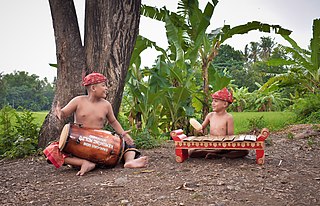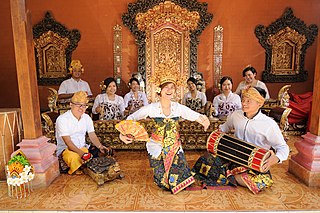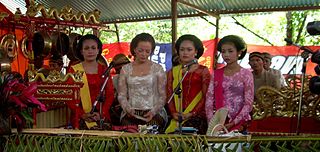
Gamelan is the traditional ensemble music of the Javanese, Sundanese, and Balinese peoples of Indonesia, made up predominantly of percussive instruments. The most common instruments used are metallophones played by mallets and a set of hand-played drums called kendhang which register the beat. The kemanak and gangsa are commonly used gamelan instruments. Other instruments include xylophones, bamboo flutes, a bowed instrument called a rebab, and even vocalists named sindhen.

The music of Indonesia demonstrates its cultural diversity, the local musical creativity, as well as subsequent foreign musical influences that shaped contemporary music scenes of Indonesia. Nearly thousands of Indonesian islands having its own cultural and artistic history and character. This results in hundreds of different forms of music, which often accompanies by dance and theatre.

Kecak, known in Indonesian as tari kecak, is a form of Balinese hindu dance and music drama that was developed in the 1930s in Bali, Indonesia. Since its creation it has been performed primarily by men, with the very first women's kecak group starting in 2006. The dance is based on the story of the Ramayana and is traditionally performed in temples and villages across Bali.

Jegog is a form of gamelan music indigenous to Bali, Indonesia, played on instruments made of bamboo. The tradition of jegog is centered in Jembrana, a region in Western Bali. In recent years jegog has started to become popular in other regions of Bali with a few groups being established in central Bali to entertain tourists. International interest has been spread by tourists visiting Bali and by recordings. There are virtually no ensembles outside of Bali with the exception of at least two groups in Japan, one in the United States and one in Germany. Jegog music is very fast, loud, rhythmic and precise. Pieces last from a few minutes to as long as thirty minutes.

The Music of Bali, Bali is an Indonesian island that shares in the gamelan and other Indonesian musical styles. Bali, however, has its own techniques and styles, including kecak, a form of singing that imitates the sound of monkeys. In addition, the island is home to several unique kinds of gamelan, including the gamelan jegog, gamelan gong gede, gamelan gambang, gamelan selunding and gamelan semar pegulingan, the cremation music angklung and the processional music bebonangan. Modern popular styles include gamelan gong kebyar, dance music which developed during the Dutch occupation and 1950's era joged bumbung, another popular dance style. In Balinese music you can also hear metallophones, gongs and xylophones.

Joged bumbung is a style of gamelan music from Bali, Indonesia on instruments made primarily out of bamboo. The ensemble gets its name from joged, a flirtatious dance often performed at festivals and parties. This style of Gamelan is especially popular in Northern and Western Bali, but is easily found all over the island. Unlike many styles of Balinese Gamelan which have sacred roles in religious festivals, Joged music is much more secular, and in many ways has become the folk music of Bali. With the rapid rise of tourism in recent decades, Joged music is now often found being performed at hotels and restaurants.

Ronggeng is a type of Javanese dance in which couples exchange poetic verses as they dance to the music of a rebab or violin and a gong. Ronggeng might have originated from Java in Indonesia, but also can be found in Sumatra and the Malay peninsula.

Gamelan semar pegulingan is an old variety of the Balinese gamelan. Dating back from around the 17th century, the style is sweeter and more reserved than the more popular and progressive Gamelan Gong Kebyar. Semar pegulingan is derived from the ancient flute ensemble gamelan gambuh which utilizes a 7 tone scale. Semar pegulingan also uses the 7 tone scale which enables several pathet to be played. Semar is the name of the Hindu God of love and pegulingan means roughly 'laying down'. It was originally played near the sleeping chambers of the palace to lull the king and his concubines to sleep. The ensemble includes suling, various small percussion instruments similar to sleigh bells and finger cymbals, and trompong - a row of small kettle gongs that play the melody. A similar type of ensemble, Gamelan Pelegongan, substitutes a pair of gendérs for the trompong as the melody carrier and plays the music for a set of dances known as legong.

Gamelan Sekar Jaya is a Balinese gamelan ensemble located in the San Francisco Bay Area. It has been called "the finest Balinese gamelan ensemble outside of Indonesia" by Indonesia’s Tempo Magazine. It performs the music and dance of Bali in many different genres of Balinese gamelan, mainly gamelan gong kebyar, gamelan angklung, gender wayang, and gamelan jegog. Past performances have also featured ensembles playing in other styles as well, including gamelan joged bumbung, kecak, gender batel, gamelan gambuh, genggong, and beleganjur. GSJ has also performed contemporary pieces featuring instruments from the Western tradition.

Kendang is a two-headed drum used by peoples from Maritime Southeast Asia. Kendang is one of the primary instruments used in the Gamelan ensembles of Javanese, Sundanese, Balinese and Terengganu, the Kendang ensemble as well as various Kulintang ensembles in Indonesia, Malaysia, Singapore, Brunei, and the Philippines. It is constructed in a variety of ways by different ethnic groups.

The bedug is one of the drums used in the gamelan. It is used among Muslims in Java for religious purposes.

A pasindhèn is a female solo singer who sings with a gamelan. They may perform in unaccompanied music, dance, or wayang performances.

Wayang wong, also known as wayang orang, is a type of classical Javanese dance theatrical performance with themes taken from episodes of the Ramayana or Mahabharata. Performances are stylised, reflecting Javanese court culture:
Wayang wong dance drama in the central Javanese Kraton of Yogyakarta represents the epitome of Javanese aesthetic unity. It is total theatre involving dance, drama, music, visual arts, language, and literature. A highly cultured sense of formality permeates every aspect of its presentation.

Gamelan gong gede, meaning "gamelan with the large gongs", is a form of the ceremonial gamelan music of Bali, dating from the court society of the fifteenth and sixteenth centuries, associated historically with public ceremonies and special occasions such as temple festivals.

Balinese dance is an ancient dance tradition that is part of the religious and artistic expression among the Balinese people of Bali island, Indonesia. Balinese dance is dynamic, angular and intensely expressive. Balinese dancers express the stories of dance-drama through the bodily gestures including gestures of fingers, hands, head and eyes.

Gandrung is a traditional dance from Indonesia. Gandrung has many variations and is popular in Bali, Lombok and East Java among the Balinese, Sasak and Javanese. The most popular variation is gandrung from the Banyuwangi region in the eastern peninsula of Java, so much that the city is often referred as Kota Gandrung or "the city of gandrung".

Gendang beleq is a dance and music performance from Lombok island, Indonesia. It is a popular performance among the native Sasak people.

Kebyar duduk is a Balinese dance created by I Mario and first performed in 1925. Inspired by the development of the quick-paced gamelan gong kebyar, kebyar duduk is named for the seated and half-seated positions taken by the dancers. It does not convey a story, but is interpretative.


















